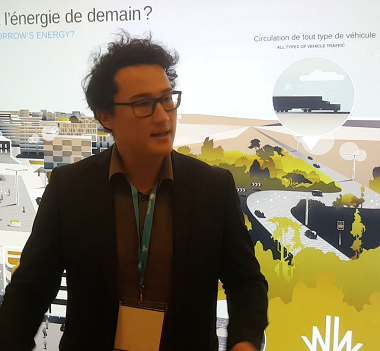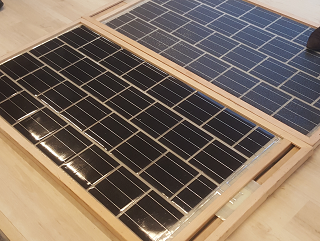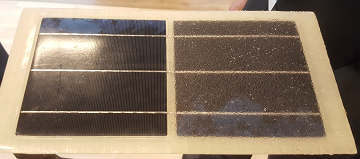  | 2025/12/ 23
|
|
|

|
  
Intelligent Transportation Systems (ITS)
The 24th Intelligent Transportation Systems (ITS) World Congress was held between October 29th and November 2nd in Montréal at the Palais de Congrès. The theme for this year's gathering was Next Generation Integrated Mobility: Driving Smart Cities.
ITS Canada defines Intelligent Transportation Systems (ITS) as the application of advanced and emerging technologies (computers, sensors, control, communications, and electronic devices) in transportation to save lives, time, money, energy and the environment.
The Montréal Congress was organized into eight Track Topics, ranging from Connectivity and Autonomy to Disruption and New Business Models. The Exhibitor Hall was a key component of this Congress, hosting more than 300 exhibitors from around the world. It featured a Smart Cities Pavilion, a focal point of the Congress.
The Smart Cities Pavilion showcased some of the best intelligent solutions, demonstrating "how cities across the globe are using technology to create their vision of next-generation integrated mobility solutions in urban settings."
WaterToday interviewed some of them at the world Congress in Montréal.
Keolis Autonomous Electric Shuttle
Aisin Group's Ily-Ai Prototype and Automated Valet Parking
The WeatherBrain
THE WATTWAY BY COLAS – ADDING FUNCTIONALITY TO EXISTING ROADWAYS
By Cori Marshall
|
 |
The Intelligent Transportation Systems (ITS) World Congress provided a window on the technological innovations that revolve around the transportation sector. One such product is the Colas’ Wattway, a system of solar panels that are embedded in the surface of a roadway or sidewalk. These panels allow roads, which up until now had a singular function, to aid in energy production.
Nicolas Griglio, Colas's Development Engineer for the United States and Canada, took time to speak with about the Wattway.
|
When asked about the solar pavement Griglio explained "Colas has been working with the French government to develop the upper road surface technology ". The Wattway becomes part of the existing infrastructure and "solar panels [placed] directly onto the ground," Griglio said.
The system is very versatile and can be used to "store energy, inject into the power [grid], and can be part of green feeding solutions."
Griglio added that "anything is possible as long as it is part of the road work or public environment."
The Wattway is currently in the testing phase, and Colas is "trying to validate some laboratory results," Griglio said. For the moment the panels are being manufactured in France, and have been installed in one thousand international locations. Griglio underlined that Colas "monitors everything, and is looking forward to the applications of tomorrow," for the solar pavement.
|  |
Griglio put the Wattway into the Canadian context and our harsh winters, explaining that the panels could be adapted to "melt snow." Currently, the Wattway contains solar panels which Griglio said "gives a second function to the road, energy production, in the future we will be able to combine it with other technology."
"The usage will be different whether you are in Canada, the US, or Africa, the system will be able to adapt," Griglio said.
The panels are 7 mm thick, and is laid on top of the road, Griglio said that "there are discussions around whether we can embed the panels into the road," for the moment they may be susceptible to snowploughs. They are covered with a coating that helps avoid vehicles sliding on the surface.
| 
|
NEW ZEALAND'S MOBILITY MARKETPLACE
By Cori Marshall
While visiting the Exhibition Hall at ITS 2017, we had the opportunity to speak with Martin McMullan, Director, Connected Journeys at the New Zealand Transport Agency.
McMullan explained what they have been working on in the last twelve months, which is the Mobility Marketplace. The concept "has all your transport options in one place, and having the ability to book and pay for them," McMullan said. It is designed for people "to have the mobility to move around Queenstown or anywhere else that we deploy the Mobility Marketplace."
In late August, Connected Journeys launched its application called Choice, which is aimed at the New Zealand tourist market. McMullan said that the app is "trilingual, English, Japanese, and simplified Chinese."
With the ease of tourists having all the Queenstown information in their own language means that more time is spent enjoying "the beauty of the mountains, adventure tourism experiences."
"We had to come up with a clear architecture, of how we were going to do that without creating a monopoly."
Martin McMullan, Director of Connected Journeys
McMullan said that "we would build the application for now, in the long-run [the Department of Transportation] does not want to be in [that] game." The approach they decided to take was one where they created a real-time messaging service that brings together all the different modes of local transit. From there "any 13, 14-year-old developer will be able to just pick it up and build it into an application very easily."
"We wanted to help innovation as much as we can," he explained, "and creating a bunch of APIs gets very technical very quickly so we took all of the heavy lifting out of it for our customers.
The payment system is designed so their customers are not continuously dependent on them. The team responsible for the Mobility Marketplace has developed close ties with different councils within the municipal administration in Queenstown.
Equally as important as the political connections are the ones made with "all the local transit operators, bus companies, taxis, rideshares, carpools, they are commercial businesses," McMullan explained, "we had to get them on board with the vision we were trying to create."
The major sticking points had to do with potential misuse of data, and data sharing with competitors. This was dealt with by not physically storing the data. McMullen describes this as "a live stream of data, just enough to give the customers what they need to make informed decisions."
The system has been up and running for a couple of months and "early signs are it’s going really well, we’ve had a bigger uptake than expected," he said, "the interesting thing is 27% of the users are downloading the application in China before they arrive in New Zealand."
McMullan said that by visitors using the transport options it will lead "to us saving lives, providing a better experience [...], and reducing congestion in and around Queenstown and its airport."
A government-developed open source concept that pulls all the transportation options in an area together. It adds an element of ease to making choices on how to get around an unfamiliar city.
|
|
|
|
Have a question? Give us a call 613-501-0175
All rights reserved 2025 - WATERTODAY - This material may not be reproduced in whole or in part and may not be distributed,
publicly performed, proxy cached or otherwise used, except with express permission.
|
|